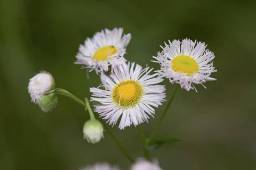SPP Plant Profile: Philadelphia or Common fleabane (Erigeron philadelphicus)
By Graduate Research Associate Evan Hayduk
Last week, SPP and CNLM staff, along with volunteers from the community, sowed more than 130 flats (about 12,748 individual cones and roughly 131,200 seeds) of Erigeron philadelphicus. What a perfect time for a SPP plant profile highlighting this species!
Basic Information
A fairly common species, Philadelphia fleabane is found across the United States as well as in most of Canada. This low-growing perennial has alternate leaves that clasp the stem, with the lowest leaves found in a basal rosette. The flowers of this species are small, pink to white with more than 100 ray flowers per head with a bright yellow center.
Ecological Importance
The pollen and nectar of this species attract many insects, including long-tongued bees, short-tongued bees, wasps, flies, butterflies, skippers, and beetles.
Fun Facts
The genus, erigeron, comes from the Greek eri (early) and geron (old man). This may refer to the early flowering of the species, as well as the hoary down that is found on the plant, reminiscent of an old man’s beard.
This species is also a widely used medicinal species. A tea made from the plant is astringent, diaphoretic, and diuretic. It has been used in the treatment of diarrhea, gout, and epilepsy. A poultice (soft, moist mass of plant material) is used to treat headaches and is applied to sores. However, treatment can induce miscarriage in pregnant women, and some people experience minor dermatitis when handling this species.
Erigeron philadelphicus is considered invasive in suburban Shanghai, China. In these areas it has been found to accumulate heavy metals including Cu, Cd, Cr, Pb and Zn in the root, leaf and stems. It has also been shown to exhibit allelopathic effects on the growth of seedlings of four crop species in the area. Aqueous extracts from the species inhibited growth of Brassica chinensis, Brassica campestris, Cucumis sativus, and Lycopersicum esculetum.

Close-up of Philadelphia fleabane. This species has more than 100 ray flowers per head. Photo by R.Gilbert.
–
